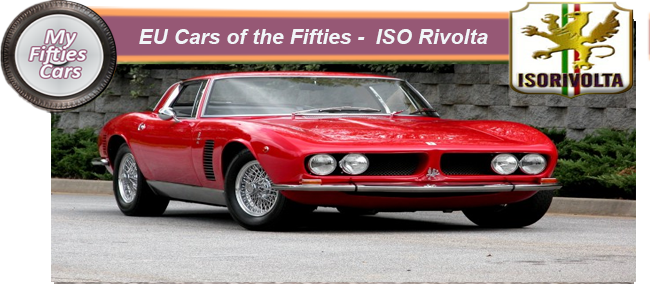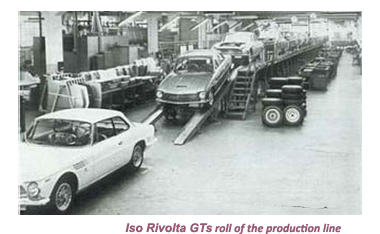 Iso Rivolta ,was founded by engineer Renzo Rivolta.
Iso Rivolta ,was founded by engineer Renzo Rivolta.
 Although in their early years, Iso focused their efforts in producing refrigerators they were best known in the post war years for producing that produced by motorcycles ,later bubble cars and finally performance sports touring cars ,remaining active until the early Seventies.
Just before the Second World War broke out in Europe Rivolta founded a company in Milan, with a view to manufacture refrigeration units. As a result of positive legisalation, the comapnt succeeded in remaining in production throughout the war years.
At the end of hostilities, Rivolta instegated a major diversification moving into the production of motor scooters and later motorcycles.
Rivolta had a magic touch, because in just five years, he succeeded in growing his company Iso Autoveicoli to become the third largest producer of two-wheel scooters behind Lambretta and Vespa.
Always on the lookout for opportunities, Rivolta began to develop and produce an interesting item of equipment know as a “Motocarry” a -three-wheeled transport scooters or motorcycles, largely manufactured from restored parts, earning them the tile of “restoration vehicles”.
Although in their early years, Iso focused their efforts in producing refrigerators they were best known in the post war years for producing that produced by motorcycles ,later bubble cars and finally performance sports touring cars ,remaining active until the early Seventies.
Just before the Second World War broke out in Europe Rivolta founded a company in Milan, with a view to manufacture refrigeration units. As a result of positive legisalation, the comapnt succeeded in remaining in production throughout the war years.
At the end of hostilities, Rivolta instegated a major diversification moving into the production of motor scooters and later motorcycles.
Rivolta had a magic touch, because in just five years, he succeeded in growing his company Iso Autoveicoli to become the third largest producer of two-wheel scooters behind Lambretta and Vespa.
Always on the lookout for opportunities, Rivolta began to develop and produce an interesting item of equipment know as a “Motocarry” a -three-wheeled transport scooters or motorcycles, largely manufactured from restored parts, earning them the tile of “restoration vehicles”.
 It soon became obvious to Rivolta that the Motocarry concept was at best a stopgap, as the sources fir restored parts would eventually dry up. The entrepreneurial engineer was already looking forward to his next step.
When it came, it was in the form of a bubble- or at least a “bubble car.”
By the mid Fifties, Rivolta threw himself and his company into the production of the
Isetta Bubble Car, a car for two people with a front door. Production got under way in 1954, with sales steady although facing strong competition from BMW among others.
The early Isettas came fitted with three wheels, but later, to improve stability,it was fitted with two more rear wheels, fitted very close together.
It soon became obvious to Rivolta that the Motocarry concept was at best a stopgap, as the sources fir restored parts would eventually dry up. The entrepreneurial engineer was already looking forward to his next step.
When it came, it was in the form of a bubble- or at least a “bubble car.”
By the mid Fifties, Rivolta threw himself and his company into the production of the
Isetta Bubble Car, a car for two people with a front door. Production got under way in 1954, with sales steady although facing strong competition from BMW among others.
The early Isettas came fitted with three wheels, but later, to improve stability,it was fitted with two more rear wheels, fitted very close together.
 With limited production facilities, Rivolta began to farm out production licensed to companies in France, Spain, the UK and as far as Brazil.
Rivolta, always looking forward, decided that the time had come to “burst his bubble “ and began winding down production on the Isetta, after having produced and sold over twenty thousand units.
With limited production facilities, Rivolta began to farm out production licensed to companies in France, Spain, the UK and as far as Brazil.
Rivolta, always looking forward, decided that the time had come to “burst his bubble “ and began winding down production on the Isetta, after having produced and sold over twenty thousand units.
![]()
Looking for the next gap in the market, Rivolta realised that the production facilities at his Milan plant were not capable of producing enough vehicles for the mass market. So he decided to leap over the fence and begin to compete in the luxury car sector.
 Renzo Rivolta called on the services of renowned designer Giorgetto Giugiaro, engineer Giotto Bizzarrini who at that time was employed by leading coach and chassic builder Bertone to work on his first release, the Iso Grifo Rivolta A3C.
Renzo Rivolta called on the services of renowned designer Giorgetto Giugiaro, engineer Giotto Bizzarrini who at that time was employed by leading coach and chassic builder Bertone to work on his first release, the Iso Grifo Rivolta A3C.
The Iso Grifo Rivolta A3C was a handsome two-door coupe built to a very high technical standard, designed to provide ultimate driving performance.
Powered by a 5.4-liter V8 Chevrolet small-block engine capable of generating 300 bhp (220 kW). There were a choice of transmissions, either manual or automatic, supplied by General Motors of Detroit. Rivolta called upon Jaguar to supply their De Dion suspension and four-wheel disc brake system, especially popular at this time. Almost all of the cars made by the Iso Grifo Rivolta A3C restoration kept this design.
Rivolta called upon Jaguar to supply their De Dion suspension and four-wheel disc brake system, especially popular at this time. Almost all of the cars made by the Iso Grifo Rivolta A3C restoration kept this design.
 In 1963, Rivolta announced the release of a luxury version of the Iso Grifo Rivolta , with the suffix A3L, with the L being an abbreviation of Lusso, which means "luxury" in Italian) for Renzo Rivolta, who wanted a follow-up to his Iso Grifo Rivolta A3C restoration of the Rivolta GT. Giorgetto Giugiaro at Bertone designed the body, while Bizzarrini worked on the mechanics.
In 1963, Rivolta announced the release of a luxury version of the Iso Grifo Rivolta , with the suffix A3L, with the L being an abbreviation of Lusso, which means "luxury" in Italian) for Renzo Rivolta, who wanted a follow-up to his Iso Grifo Rivolta A3C restoration of the Rivolta GT. Giorgetto Giugiaro at Bertone designed the body, while Bizzarrini worked on the mechanics.
![]()
In the same year, Iso Rivolta Bertone showed off their Grifo A3/L prototype at the Turin Auto Show, as well as a partially completed version of what was to be the Grifo A3C competition car. Positive responses were forthcoming for both models.
 Next to come from the creative mind of Renzo Rivolta and his design and production team was the Grifo A3/L Spyder, that went into production in 1965, Very few were sold, although those who were went on to become major collector’s items. Iso Grifo Rivolta A3C Restoration.
Next to come from the creative mind of Renzo Rivolta and his design and production team was the Grifo A3/L Spyder, that went into production in 1965, Very few were sold, although those who were went on to become major collector’s items. Iso Grifo Rivolta A3C Restoration.
 The dramatic success of Iso Rivolta came to a tragic halt in August of 1996, with sudden and unexpected passing or Renzo Rivolta. Rivolta was only 58 years of age when he passed.
The dramatic success of Iso Rivolta came to a tragic halt in August of 1996, with sudden and unexpected passing or Renzo Rivolta. Rivolta was only 58 years of age when he passed.
 The reins were rapidly handed over to Piero Rivolta, Renzo’s 25 year old son.
The feeling was that under Piero's direction, Iso Grifo Rivolta would falter.
Piero looked to be proving the critics wrong in 1967 when he announced the launch of Fidia, a limousine advertised as "the fastest four-seater on wheels".
However, the weight of responsibility and the lack of experience were to prove too much for Piero and things started to come adrift for Iso Grifo Rivolta, causing the company to experience growing financial difficulties, till they had no option but to declare bankruptcy in 1974.
The reins were rapidly handed over to Piero Rivolta, Renzo’s 25 year old son.
The feeling was that under Piero's direction, Iso Grifo Rivolta would falter.
Piero looked to be proving the critics wrong in 1967 when he announced the launch of Fidia, a limousine advertised as "the fastest four-seater on wheels".
However, the weight of responsibility and the lack of experience were to prove too much for Piero and things started to come adrift for Iso Grifo Rivolta, causing the company to experience growing financial difficulties, till they had no option but to declare bankruptcy in 1974.

